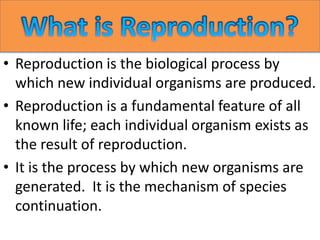
Reproduction in animals
- 1. • Reproduction is the biological process by which new individual organisms are produced. • Reproduction is a fundamental feature of all known life; each individual organism exists as the result of reproduction. • It is the process by which new organisms are generated. It is the mechanism of species continuation.
- 2. • Asexual reproduction is a primitive method of reproduction without participation of a mate, gamete or fertilization. • The common types of asexual reproduction in animals are: 1. Fission (ex: Amoeba, Plasmodium) 2. Budding (ex: Hydra, Sponges, Corals) 3. Regeneration (ex: Worms, Echinoderms) 4. Fragmentation (ex: Sponges) 5. Parthenogenesis (Honey bees, Ants, Wasps) 6. Cloning ( artificial method)
- 3. • Sexual reproduction is more common in unstable or unfavorable circumstances. • Significance 1. It is important to avoid genetic monotony. 2. It creates variations in species. 3. New species facilitate evolution of organisms. • Necessities 1. Gametogenesis (Formation of gametes) 2. Mating or copulation (Contribution of gametes) 3. Fertilization (Fusion of gametes)
- 4. • A pair of testes Cowpers gland • Epididymis • Vas deference • Urethra • Penis • Three types of accessory glands 1. Seminal vesicles 2. Prostate gland 3. Cowper’s gland
- 5. Structure of Testes Testes (testicles): • These are small, solid, oval bodies packed with tightly coiled Seminiferous tubules which produce sperms and androgens (male sex hormones). • The most common androgen is called testosterone. Androgens cause males to develop male secondary sexual characteristics at puberty. Scrotum: • Before birth, testes descend down in a pouch like structure that hangs behind the penis. • It holds and protects the testes and allows the development of sperms at low temperature than body temperature. • It also contains numerous nerves and blood vessels. • The penis and scrotum makes the external genetalia.
- 6. • The testes consist of a mass of coiled tubes called semeniferous tubules in which the sperms are formed by meiosis. Cells lying between the semeniferous tubules produce the male sex hormone • When the sperm are produced they are stored in an about 6m long, thin tube, the where they become mature and motile before moving to the . • The two sperm ducts join the just below the bladder, which passes through the and transports both sperm and urine.
- 7. Accessory Glands • Three different glands may be involved in producing the secretions which mixes with sperm and make male genital fluid semen or seminal fluid. :When present they produce secretions that make up much of the volume of the semen, and transport and provide nutrients for the sperm. 2. P :It produces an alkaline secretion that neutralizes the acidity of the male urethra and female vagina. It has various functions in different species. Its secretions may lubricate and neutralizes the acidity of urethra caused by the passage of urine.
- 10. Structure of a Sperm A Sperm consists of three parts: a head consisting mainly of the nucleus, a midpiece containing many mitochondria to provide the energy and a tail that provides propulsion. tail
- 11. • A pair of ovaries • Fallopian funnel • Uterus • Cervix • Vagina
- 13. • The ovaries are a pair of oval or almond-shaped structures which lie on either side of the uterus and just below the opening to the fallopian tubes. • In addition to producing eggs or "ova," the ovaries produce female sex hormones called estrogen and progesterone. • The ovaries, unlike the testes, does not manufacture the sex cells rather 200,000 oocytes are present in each ovary at the time of birth which are contained in sac-like depressions in the ovaries.
- 14. • The fallopian tube extends from the uterus to the ovary. This tube carries eggs and sperm and is where fertilization of the egg, or "ovum" takes place. • The fallopian tubes lie in the pelvic portion of the abdominal cavity and each tube reaches from an ovary to become the upper part of the uterus. • This funnel-shaped tube is about three inches in length. The larger end of the funnel is divided into feathery, finger-like projections which lie close to the ovary. • Their beating projections, along with muscle contractions, force the ovum down the funnel's small end, which opens into the uterus.
- 15. The Uterus • The uterus is a hollow, pear-shaped organ that is the home to a developing fetus. • The uterus is divided into two parts: the , which is the lower part that opens into the vagina, and the main body of the uterus, called the • The lower one-third of the uterus is the tubular "cervix," which extends downward into the upper portion of the vagina.
- 16. • The vagina is a muscular passage which forms a part of the female sex organs and which connects the neck of the uterus called cervix with the external genitals. • The vagina has three functions: 1. as a reception for the sperms 2. as outlet for blood during menstruation 3. as a passageway for the delivery of feotus at birth.
- 17. Oogenesis
